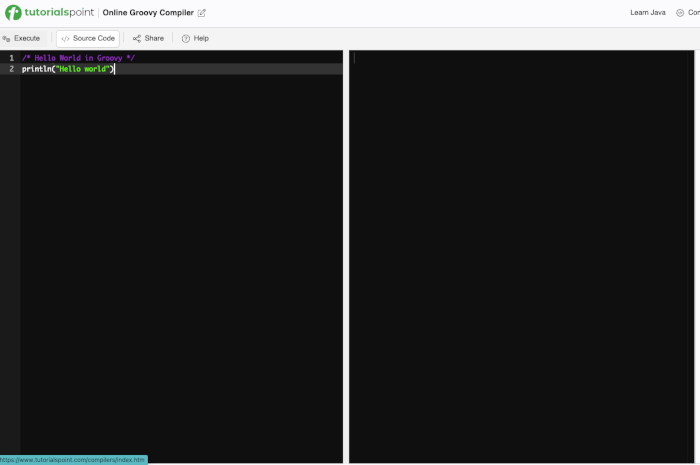Groovy closures go beyond basic syntax and scope — they offer powerful functional programming features like currying, memoization, and composition. These techniques can help you write cleaner, more efficient, and more reusable code.
In this tutorial, you'll explore some advanced closure capabilities that unlock even more potential from Groovy scripts.
Preparation
Make sure Groovy is installed. You can use:
- SDKMAN (Linux/macOS):
sdk install groovy- Groovy Console for interactive editing:
groovyConsoleOnline editors like TutorialsPoint Groovy Editor https://www.tutorialspoint.com/compilers/online-groovy-compiler.htm

Save code in ClosureScopeExample.groovy and run with groovy ClosureScopeExample.groovy.
Currying in Groovy
Currying is the process of fixing several arguments to a function, producing another function of smaller arity (fewer parameters).
Example: Left Currying
def multiply = { a, b -> a * b }
def double = multiply.curry(2)
println double(5) // Output: 10The double closure is a new function where a is always 2.
Right Currying
def triple = multiply.rcurry(3)
println triple(4) // Output: 12Index Currying (Mid-position)
def divide = { a, b, c -> (a + b) / c }
def curried = divide.ncurry(1, 4) // Fix second argument (index 1) to 4
println curried(6, 2) // Output: 4.0
Memoization
Memoization caches closure results for improved performance with expensive operations.
Basic Memoization
def fib
fib = { n ->
if (n < 2) return n
fib(n - 1) + fib(n - 2)
}.memoize()
println fib(30) // Much faster due to cachingYou can also use:
- .memoizeAtMost(n)
- .memoizeAtLeast(n)
- .memoizeBetween(min, max)
Closure Composition
Groovy allows you to compose closures for cleaner and modular transformations.
Example: Function Composition
def upper = { it.toUpperCase() }
def exclaim = { it + '!' }
def excited = upper >> exclaim
println excited('groovy') // Output: GROOVY!- >> composes from left to right
- << composes from right to left
Trampolining (Avoiding Stack Overflow)
Trampolining allows recursion without blowing the stack by deferring evaluation.
def factorial
factorial = { n, acc = 1 ->
if (n == 1) return acc
return factorial.trampoline(n - 1, n * acc)
}.trampoline()
println factorial(1000) // Safe from StackOverflow
Closure as a Strategy
Closures are perfect for strategy patterns or dynamic behavior.
def taxStrategy = { amount -> amount * 0.2 }
def calculateTax = { amount, strategy -> strategy(amount) }
println calculateTax(100, taxStrategy) // Output: 20.0
Conclusion
In this tutorial, you've explored powerful features of advanced Groovy closures:
- Currying to create reusable partial functions
- Memoization to optimize performance
- Composition to build modular behavior
- Trampolining for safe recursion
These tools make Groovy an expressive and efficient language for both scripting and real-world applications.
Next, we’ll explore Groovy Closures in Real-World Scripts — where you'll apply closures to file processing, configuration, and more.
You can find the full source for this tutorial on our GitHub.
That's just the basics. If you need more deep learning about Groovy and Grails, you can take the following cheap course:
- The Complete Apache Groovy Developer Course
- Groovy Fundamentals For Testers - Step By Step
- Groovy Programming Fundamentals for Java Developers
- The Complete Jenkins DevOps CI/CD Pipeline Bootcamp
- WebServices/API Testing by SoapUI & ReadyAPI - Groovy |30+hr
- Mastering Grails. A Comprehensive Grails Course.
- Intro to web programming with Groovy on Grails
Thanks!
